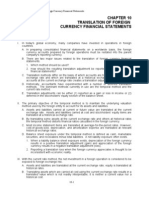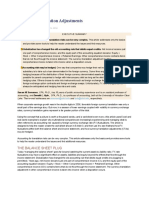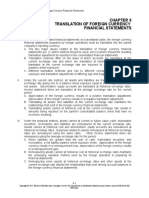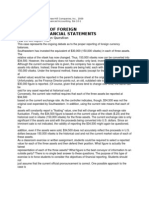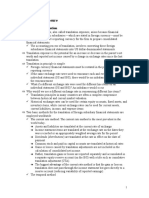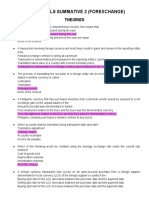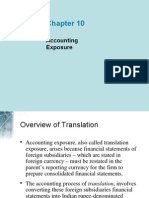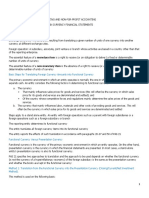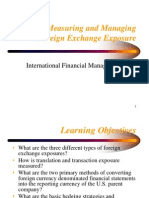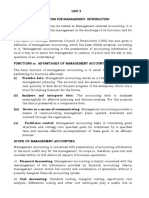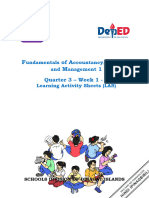Tutorial 8
1. Translation. How do MNEs translate foreign currency into functional currency when
consolidating their financial statements?
Foreign currency is most commonly translated into functional currency when MNEs combine the financial
statements of their subsidiaries into one consolidated financial statement. The following are the basic steps
that a parent MNE must follow to translate foreign currency amounts into the functional currency. First, after
clearly determining its functional currency, the MNE translates all foreign currency items of its subsidiaries
into its functional currency. When reporting a foreign currency transaction, it should be recorded initially at
the rate of exchange at the date of the transaction, but when it is to be translated, it must be recorded at the
closing exchange rate at the date of the financial statement.
6. Functional Currency. What are the factors involved in the determination of the functional
currency of a firm?
A functional currency is the primary currency and the monetary unit of account that a company uses in its
business activities. There are a number of factors that an MNE considers when determining the functional
currency of each of its subsidiaries. If most of the operations of the subsidiary are in the form of sales in the
domestic market, then in order to comply with local regulations and to easily manage and benchmark sales
prices against those of competitors, it is best that the functional currency is that of the host country. If the
subsidiary is export-oriented, then the functional currency usually selected is the one that primarily influences
sales prices and in which prices are denominated and settled. Further, if the operations of the subsidiary depend
largely on a large component of imported inputs, then the functional currency may be selected as the one in
which prices of inputs are denominated and settled. However, in many cases if the MNE is operating in
jurisdictions with relatively stable foreign exchange prices, then it can select the currency of the country in
which it is headquartered as the functional currency.
12. Translation Exposure Management. What are the primary options firms have to manage translation
exposure?
The main technique to minimize translation exposure is called a balance sheet hedge. A balance sheet hedge
requires an equal amount of exposed foreign currency assets and liabilities on a firm’s consolidated balance
sheet. If this can be achieved for each foreign currency, net translation exposure will be zero.
Some firms have attempted to hedge translation exposure in the forward market—with forward contracts.
Such action amounts to speculating in the forward market in the hope that a cash profit will be realized to
offset the noncash loss from translation. Success depends on a precise prediction of future exchange rates, for
such a hedge will not work over a range of possible future spot rates. In addition, the profit from the forward
“hedge” (i.e., speculation) is taxable, but the translation loss does not reduce taxable income.
The following circumstances could justify when to use a balance sheet hedge:
1. The foreign subsidiary is about to be liquidated, so that the value of its CTA would be realized
2. The firm has debt covenants or bank agreements that state the firm’s debt/equity ratios will be maintained
within specific limits
3. Management is evaluated on the basis of certain income statement and balance sheet measures that are
affected by translation losses or gains
4. The foreign subsidiary is operating in a hyperinflationary environment
�Problem 11.8
Bangkok Instruments, Ltd., is the Thai affiliate of a U.S. seismic instrument manufacturer. Bangkok
Instruments manufactures the instruments primarily for the oil and gas industry globally, though with
recent commodity price increases of all kinds -- including copper -- its business has begun to grow
rapidly. Sales are primarily to multinational companies based in the United States and Europe. Bangkok
Instruments’ balance sheet in thousands of Thai baht (B) as of March 31st is as follows.
Using the data presented, assume that the Thai baht dropped in value from B30/$ to B40/$ between
March 31st and April 1st. Assuming no change in balance sheet accounts between these two days,
calculate the gain or loss from translation by both the current rate method and the temporal method.
Explain the translation gain or loss in terms of changes in the value of exposed accounts. Historical rate is
B20/$.
�Note:
Baht/US$ 34 - Current Rate Method 72,000/2,100 = 34
Baht/US$ 23 - Temporal Rate Method 72,000/3,100 = 23
Temporal Method:
1. Monetary assets/liabilities translated at current rate
• Cash, Account Receivable
• Accounts Payable, Bank Loan
2. Nonmonetary assets/liabilities translated at historical rate
• Net Plant, Equipment
• Inventory: if mentioned in the problem then historical rate is applicable. Otherwise if nothing
is mentioned then assume recently acquired so current rate is applicable.
3. Equity items translated at historical rate
• Common Stock
�Rule of thumb under Current Rate Method and Temporal Rate Method.
Problem 11.9
Using the original data provided for Bangkok Instruments provided in Problem 11.8, for this problem
please assume that the Thai baht appreciated in value from B30/$ to B25/$ between March 31 and April
1. Assuming no change in balance sheet accounts between those two days, calculate the gain or loss from
translation by both the current rate method and the temporal method. Explain the translation gain or loss
in terms of changes in the value of exposed accounts. Historical Rate is B20/$.
�Answer: CTA Balance GAIN $600.
Temporal Balance LOSS $120


